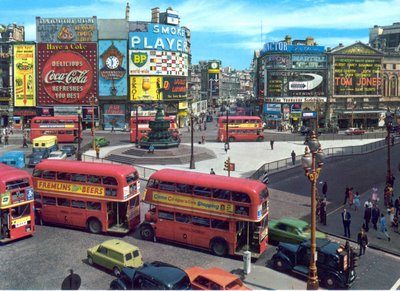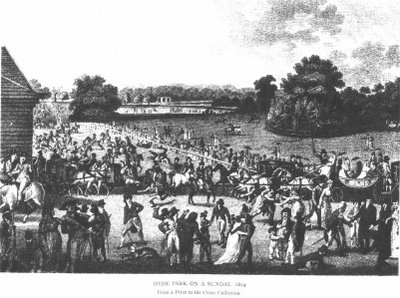 Having moved very recently to London, all I hear is "Welcome to London!" "Welcome to London!" Sometimes this is said in a serious tone, as if becoming a 'Londoner' is something to be congratulated on. At other times it is accompanied with an ironic twist of a smile and a sharp glint in the eye, as if to say, "Welcome, but we'll see how long you're still smiling." All in all it is very welcoming. Even the shopkeepers smile and say, "How are you?" But more importantly, there's something in the air, something that's proving particularly felicitous for a fashion writer new to London. Everywhere I go - Paddington, Victoria, King's Cross - rolling screens display pouting, life-size models, all of whom move endlessly down pristine catwalks whilst enchanted faces gaze from the sidelines. I find myself stopping among the London hordes, disturbing the businessmen who walk hurriedly by me, whilst I stare, entranced by these impassive creatures. It's enough to take your breath away.
Having moved very recently to London, all I hear is "Welcome to London!" "Welcome to London!" Sometimes this is said in a serious tone, as if becoming a 'Londoner' is something to be congratulated on. At other times it is accompanied with an ironic twist of a smile and a sharp glint in the eye, as if to say, "Welcome, but we'll see how long you're still smiling." All in all it is very welcoming. Even the shopkeepers smile and say, "How are you?" But more importantly, there's something in the air, something that's proving particularly felicitous for a fashion writer new to London. Everywhere I go - Paddington, Victoria, King's Cross - rolling screens display pouting, life-size models, all of whom move endlessly down pristine catwalks whilst enchanted faces gaze from the sidelines. I find myself stopping among the London hordes, disturbing the businessmen who walk hurriedly by me, whilst I stare, entranced by these impassive creatures. It's enough to take your breath away.
The explanation: it's London Fashion Week.
Before I get too carried away, I'd like to remind you all of the imporant role that London has played in the changing history of men's style, from the earliest days of the Restoration through to the innovations of the Swinging Sixties and the 21st century focus on online tailoring, exemplified by the cutting-edge garment house 'A Suit That Fits'.
The earliest equivalent of the modern day catwalk can be found in the 18th century, when the male members of London's top aristocratic families would parade up and down Hyde Park to show off their beautiful clothes; this was known as the 'Fashionable Hour', though it was, in fact, three hours, from 4.30 to 7.30. Given what we know about 18th century fashion, it must have been an impressive sight. Hand-sewn coats with wide skirts pleated into tight waists were worn over breeches and ruffled shirts. These were often blood red or deep blue or a more subdued black or brown, all of which were popular with the 18th century gentlemen. Today one can only imagine the sight of it - hundreds of gentlemen in brightly coloured coats sauntering beneath a pale blue sky in Hyde Park. "Such a blaze of splendour," said one commentator, "is now to be seen nowhere but in London..."

Towards the end of the 18th century, a strange phenomenon began to spread through the theatres, opera houses and parks of London: the rise of the dandy. The dandy was a sophisticated young man, usually characterised by immaculate personal cleanliness and close attention to appearance. He wore high-collared linen shirts and perfectly tailored pantaloons, partly inspired by the garments of the working class masses, who dominated France after the French Revolution. Whilst the Terror raged on the other side of the channel, a certain darkness, or severity of expression, reigned on the London scene, with black becoming increasingly popular.

With the dawn of the postmodern era in the 20th century and the sexual revolution of the 1960s, all these styles and more were borrowed and blended to create unusual, retro looks. London swung to a different beat and boho-chic was all the rage. Think Mick Jagger, a kind of drug-addled Romantic in ruffled shirt and silk-cravat, or the Beatles, sharp-suited Englishmen with Beatnik hair. Styles proliferated and no 'look' predominated. The individual wore what he wanted when he wanted to wear it.
Now, in the 21st century, grunge is out and tailoring is back. Brand new garment houses such as A Suit That Fits are offering quality tailoring at affordable prices. Thanks to this modern innovation in fashion, even Joe Bloggs can take part in the ancient history of tailoring. When Paul Smith unveiled his collection this week, the beauty of bespoke tailoring was vindicated once more. The suit is evidently the thing to be in.
No comments:
Post a Comment